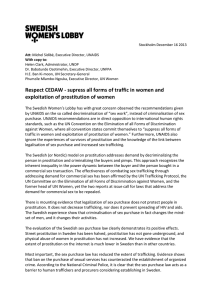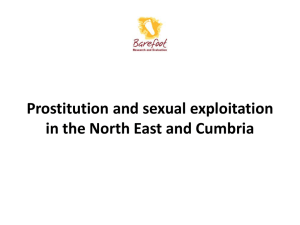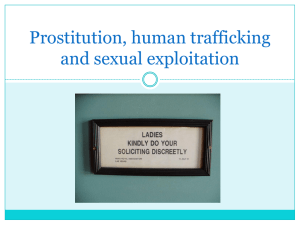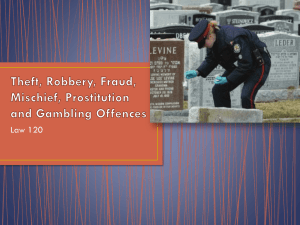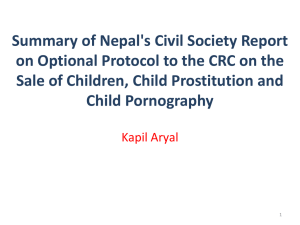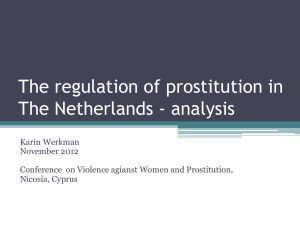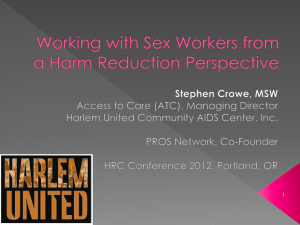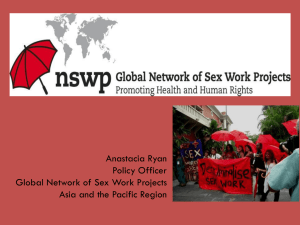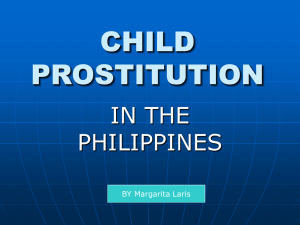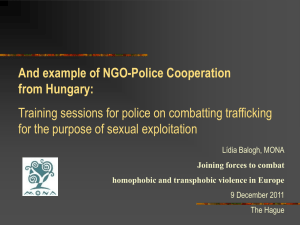Operationalizing ideas on sex work/prostitution
advertisement
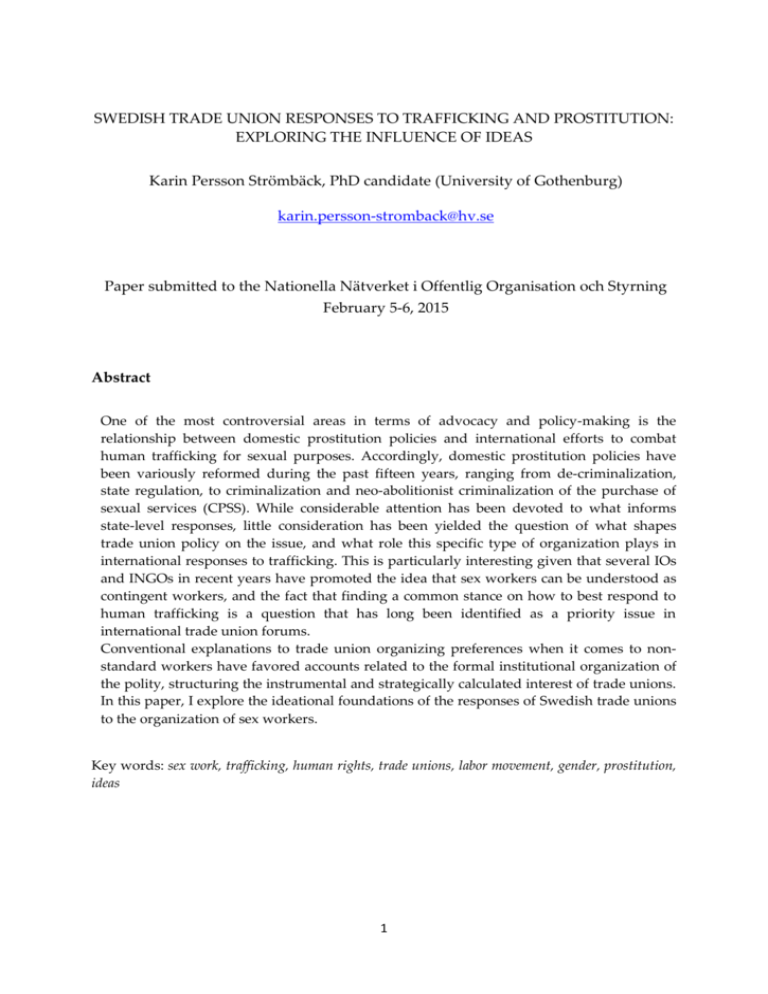
SWEDISH TRADE UNION RESPONSES TO TRAFFICKING AND PROSTITUTION: EXPLORING THE INFLUENCE OF IDEAS Karin Persson Strömbäck, PhD candidate (University of Gothenburg) karin.persson-stromback@hv.se Paper submitted to the Nationella Nätverket i Offentlig Organisation och Styrning February 5-6, 2015 Abstract One of the most controversial areas in terms of advocacy and policy-making is the relationship between domestic prostitution policies and international efforts to combat human trafficking for sexual purposes. Accordingly, domestic prostitution policies have been variously reformed during the past fifteen years, ranging from de-criminalization, state regulation, to criminalization and neo-abolitionist criminalization of the purchase of sexual services (CPSS). While considerable attention has been devoted to what informs state-level responses, little consideration has been yielded the question of what shapes trade union policy on the issue, and what role this specific type of organization plays in international responses to trafficking. This is particularly interesting given that several IOs and INGOs in recent years have promoted the idea that sex workers can be understood as contingent workers, and the fact that finding a common stance on how to best respond to human trafficking is a question that has long been identified as a priority issue in international trade union forums. Conventional explanations to trade union organizing preferences when it comes to nonstandard workers have favored accounts related to the formal institutional organization of the polity, structuring the instrumental and strategically calculated interest of trade unions. In this paper, I explore the ideational foundations of the responses of Swedish trade unions to the organization of sex workers. Key words: sex work, trafficking, human rights, trade unions, labor movement, gender, prostitution, ideas 1 Introduction In recent years, prostitution and trafficking has become exceedingly politicized. Policy actors have construed and engaged in constructing the phenomena in various ways, ranging from perceiving and promoting trafficking as an issue of border related security in destination countries, to underdevelopment and poverty, lack of migration opportunities, and the exclusion of migrant women from debates on women’s rights in countries of origin. Scholars can be divided into two broad clusters in terms of what informs policy responses to trafficking. Whereas the traditional Copenhagen School inspired security scholarship understand policy responses as informed by the perception of trafficking as a threat to the sovereign state, by among other things inflows of undocumented migrants and international criminal networks (see: Buzan & Waever, 1993), feminist approaches instead shift focus from the protection of the state to the individual, and among other things stress human rights, gender equality, security for transnational migrants, worker protection, as well as status of prostitution regime (Lobasz, 2009:320-22). Among those who adopt a feminist analysis of the commercial sex trade, there is a great discrepancy in how the problem of commercial sex is understood. Indeed, the meaning of the term trafficking is ambiguous in itself. This is argued to be related to the difficulty to conceptually distinguish between those who are trafficked, smuggled, and those who migrate voluntary across borders to improve their own or their family’s situation (Demleitner, 2001:261). By framing the issue as a question of gender (in)equality in countries of destination, the argument frequently voiced by supporters of CPSS is that this approach curbs the demand for sexual services - and thus - the appeal of the country as a potential market for traffickers. Tied in to this view is the perception that CPSS not only makes it an offense to pay for sex; it alters public opinion of whether or not it is acceptable to do so by making explicit that sex workers are victims of men’s violence against women. By and large, trafficking and prostitution is perceived to be a result of male demand, two sides of the same coin, and the ultimate symbol of gender inequality. While promoters of CPSS employ abolitionist arguments asserting a causal relationship between legalized or regulated prostitution and increased trafficking, critics of a demand side ban and outright criminalization raise the issue of the conflation of voluntary adult sex work with coerced human trafficking and sexual exploitation of children, as well as the confusion between migrant sex work and trafficking. Stressing the importance of separating forced trafficking and prostitution 2 from the human and labor rights of sex workers has consequently led to that the issue has ended up on the table of the labor movement. Indeed, finding a common stance on how to best respond to human trafficking is a question that has long been identified as a contentious issue. In 1999, the International Labour Organisation (ILO) published the controversial report “The Sex Sector: The Economic and Social Base of Prostitution in Southeast Asia” which called on governments to recognize prostitution as an occupation with protection under labor law, social security and health regulations, as to reach a common international practice on how to tackle human trafficking for sexual purposes and child prostitution (Lean, L.L, 1998:2). The report was met with great protest, but since then, several IOs and INGOs have moved towards the idea of a separation between forced and voluntary sex work, and the need for labor rights in order to come to terms with forced trafficking and the human security of sex workers. In 2010, The UN special rapporteur on the Right to Health called for the decriminalization of sex work, stating that “[…] the failure of legal recognition of the sexwork sector results in infringements of the right to health, through the failure to provide safe working conditions, and a lack of recourse to legal remedies for occupational health issues. Additionally, the distinction between sex work and trafficking is considered, in particular with respect to legislation and interventions that, by failing to distinguish between these groups, are increasingly infringing sex workers’ right to health.1” The 2012 report by the Global Commission on HIV and the Law - an independent body convened by the UN Development Programme (UNDP) on behalf of the Joint United Nations Programme on HIV/AIDS (UNAIDS) - proposed support for the trade unionization of sex workers as a means to decrease stigmatization and combat the spread of HIV (UNDP, 2012:40). The same year, The World Health Organization (WHO) called all countries to “work toward decriminalization of sex work and elimination of the unjust application of non-criminal laws and regulations against sex workers2”. In 2013, UN Women stated that as a UNAIDS sponsor, it “supports the decriminalization of sex work in order to ensure the access of sex workers to all services3”. Most recently, Amnesty International published a policy consultation on decriminalization of sex work where it stated that it “opposes the criminalisation or punishment of activities relating to the buying or selling of consensual sex between adults4”. Human Rights Council (2010) WHO (2012) p. 8 3 UN Women (2013) 4 Amnesty (2014) p. 1 1 2 3 The first time a common European trade union statement on labor rights for sex workers was brought up however, was during an European Trade Union Confederation (ETUC) congress in Seville 2007. During discussions of an action plan dealing with flexicurity, Dutch labor union representatives suggested an amendment, which mentioned the importance of international cooperation around the problem of unofficial labor. The amendment advocated joint action against trafficking and forced prostitution, but also stressed the importance of human and labor rights for sex workers5. Why Sweden? Scholars agree that the Swedish adoption of a neo-abolitionist prostitution policy, enacted in 1999, was successful because policy entrepreneurs managed to establish linkages between gender ideas regarding inequality between men and women and the proposed ban on the purchase of sexual services (Dodillet, 2009; Gould, 2001; Ekberg, 2004). There is no doubt that the Swedish model has had a great normative impact on domestic policy-making through processes of policy diffusion (Stone, 2004). Soft power persuasion, or the promotion of the inherent appeal of Swedish norms, and the manner in which they can be accommodated in existing domestic normative and ideational frameworks, as well as policy learning, has been frequent (Acharya 2004; Checkel, 2005; Dolowitz and Marsh, 2000). However, while accounts of prostitution policy diffusion between Sweden and other countries have been studied previously, ‘bottom-up’ policy diffusion between Swedish policy actors and International Organizations (IOs) has been overlooked. As argued by Diane Stone (2004), policy transfers also occur between transnational nonstate actors and vertically between states and IOs (Stone, 2004:549). Swedish trade unions are promoting Swedish ideas internationally, through among other channels The International Trade Union Confederation (ITUC), its Pan European Regional Council (PERC) and the European Trade Union Confederation (ETUC). Therefore, gaining a more thorough understanding of what informs trade unions policy positions is a vital piece in the puzzle when attempting to explain the emergence and possible future of prostitution and anti-trafficking policies. 5 2.40-2.41 (Add a new paragraph between 2.40 and 2.41) Special attention must be given to the trafficking of human beings and especially women and children for the purpose of sexual exploitation. The ETUC strongly believes that everything must be done to counter trafficking and forced prostitution, and that the victims of trafficking must receive adequate protection. The combat of trafficking and forced prostitution must be explicitly linked to the respect and dignity, human and labour rights of these persons, including the right to organize. 4 Furthermore, if accepting the notion that industrial relations institutions are socially constructed in the particular sense that they are a congealed form of class power that is - they reflect a particular moment of class power at the time of their construction, Sweden becomes a critical case. Swedish trade unions were involved in the construction of sexual inequality as a political problem as early as in the 1960s. A common - and rational-economical explanation for the entrance of women into the wage-labor market is that Sweden began to experience a labor shortage in the mid-1950s. Swedish trade unions saw women as a superior alternative to reliance on immigrant labor, and thus began supporting women’s rights to leave the domestic sphere (Jonung & Thordarsson, 1980). An example of this dynamic is provided by Besbo (2012), who makes a convincing argument for why social and economic legislative changes related to women’s rights during the period 1921-1971 – at a first glance giving off the impression of being programmatic resolutions to the problem of women’s economic independence and gender inequality - rather was driven by governmentality; a means to resolve other “superior” social problems. This rational logic to women’s emancipation was indeed present in several areas of social and economic change. As Bersbo (2012) puts it; “rights and other social benefits would steer them into serving what was regarded as the public good […] Swedish women´s extended rights and other social benefits were not implemented to create possibilities for women to achieve economic independence, but as a means to resolve other superior social problems6” Paper outline This paper proceeds by first addressing a set conventional explanations to trade union preferences in terms of organizing non-traditional members. I note that this literature has largely neglected the role of ideas, and instead considers trade union preference in terms of organizing hard to reach groups a more or less path dependent process derived from the formal institutional context. Following that, I question these explanations by giving a brief account of how Swedish unions have become increasingly positive to the organization of undocumented migrants while remaining hostile, and at times indifferent, to the organization of sex workers. I continue by mapping out the contending ideas defining sex work in feminist debates over trafficking and prostitution, as to be able to identify which ideas trade union actors draw on when justifying their positions in terms of commercial sex. I then trace the influence of ideas on the policy stances of Swedish unions from the initial 6 5 attempts of Swedish sex workers to seek organizational support in 2002-2003, and the negotiations that took place during the 2007 ETUC congress where a common European trade union policy-stance on the organization of sex workers was raised for the first time. I conclude by suggesting that the presence of a powerful ideational frame of gender equality has managed to trump possible ‘material’ incentives, which is suggested by previous research to be the main source of trade union preferences in terms of organizing atypical and non-standard workers. The rational-institutional explanation While there are few studies exploring the relationship between organized labor and commercial sex (see: Gall, 2006; 2007; 2010), a broad strand of literature often labeled the “revitalizing” literature contributes to a greater comprehension of what impacts on organized labor’s policy stance on atypical non-standard labor. This set of literature stems from comparative political science research on trade unions in advanced industrial democracies. Some scholars have focused on trade union interests and scope of action in terms of organizing the informal sector more broadly, while others have adopted a more narrow approach by exploring trade union approaches towards illegal migration. These accounts assume that conflict over scarce resources lie at the heart of the politics of unions. Central to the analyses is the formal institutional organization of the polity, which structures the instrumental and strategically calculated interest of unions (Hall and Taylor, 1996). From these perspectives, interest in organizing informal, a-typical, or non-standard workers7 is determinant on how ‘strong’ trade unions are. This literature has primarily focused on how unions in the global south have adopted strategies to overcome problems related to a vast informal economy. However, as European trade unions increasingly have encountered membership stagnation and even decline over the past two decades, industrial relations scholars have begun to draw attention to the reform efforts European trade unions must accomplish to come to terms with declining power and influence. A number of studies have sought to demonstrate how increased economic internationalization, increased employer opposition, and a higher number of people working in the informal sector has been the driving force behind the extensive trade union membership decline across Europe during the last decade, referred to as ‘deunization’ (Boeri, Brugiavini & Calmfors, 2001:55). 7 Refers to part time workers, those with temporary employment, or workers without employees - especially prevalent among women, low skilled, and migrant workers (see: Vandaele & Leschke, 2010) 6 One of the main criticisms of European trade unions is that they have failed to develop alliances with social movements, which is considered essential for building political power and reverse decline (Frege and Kelly, 2004:2). The ‘factory paradigm’, referring to that trade unions in Western democracies are caught in strong institutional path dependency where conditions of suitability and adequacy are insisted on although these conditions no longer reflect the realities of contemporary work and employment (e.i. the most common worker is no longer a white male with a permanent employment contract), is perceived as one of the greatest problems European trade unions must come to terms with (Cumbers, 2005). Thus, interest in the informal sector and how it can be reached by organized labor has received increased attention. By drawing on the Varieties of Capitalism framework, Frege and Kelly (2003; 2004) analyze strategies of union renewal. They find that labor unions face different opportunity structures due to the institutional context in which they operate, and the strategies trade unions choose and develop in terms of renewal and revitalizing are contingent on this. In the edited volume “Varieties of Unionism”, Frege and Kelly show that strategies of organizing previously ignored groups were on the agenda in all the countries under investigation (Frege and Kelly, 2004:45). However, due to the institutional context, the importance of organizing the unorganized was much more important in the United Kingdom (UK) and the United States (US) than in countries where unions held a stronger position (Frege and Kelly, 2004:63). Differences in institutional position and degree of political support are perceived as important for which strategies unions adopt. Accordingly, in countries where the traditional institutional channels are blocked and membership density is low, unions are argued to be more prone to move towards an increased interest in coalition building with various grass-root movements (Baccaro, Hamann & Turner, 2003:120). In countries where the union’s institutional position is stronger, and membership density levels are high, unions are assumed to rely more heavily on social partnership with the government and employer organizations, a strategy referred to as ‘political unionism’. Criticism of political unionism contends that many Western trade unions are overly tied to, or even subordinated to political parties. For example, Upchurch and Mathers argue that the cost for trade unions that are profoundly bureaucratically institutionalized in welfare states is that they have had to abandon mobilization and their old radical agenda (Upchurch and Mathers, 2011:4). According to the revitalizing literature, unions adhering to political unionism thus become prone to de-emphasize the mobilization of new members, as declining membership rates does 7 not cause the same immediate threat to the survival of the union (Dolvik & Waddington, 2004; Baccaro, Hamann & Turner, 2003:129, Frege and Kelly, 2003:10). Following this logic, Rainnie and Ellem (2006) suggest that “labour movements at whatever level have to experience near terminal crisis before the rigidities of old structures, attitudes and activities can be opened up to new and challenging ways of organizing8”. Taken jointly, the ‘revitalizing’ literature implies that unions with a high membership rate and strong institutional position should be less prone to organize informal workers, while ‘weaker’ unions have a greater incentive to seek out and/or accept proposals from these types of groups. In the words of Baccaro, Hamann & Turner; “If unions find or build adequate political and institutional support, they have less incentive to mobilize the membership, organize the unorganized, build coalitions with other groups, or give support to grass-root initiatives.9” The revitalizing literature hence understand trade union interests in adopting renewed strategies and seeking out ‘hard to organize’ groups as a process derived from the specific formal institutional contexts; whether unions perceive the inclusion of atypical or non-standard workers as a necessary strategy to maintain a position as influential organizations within the polity is primarily derived from material strategic incentives. Explanations to the exclusion/inclusion of atypical or non-standard workers adhering to union strength thus have clear connections to one of the many approaches explaining actor identities and interests; rational choice institutionalism. Here, institutions serve as a strategic context that provide incentives influencing the strategies actors pursue to attain given ends, and act as constrains on the behavior of self-interested actors (Checkel, 1999:546). In the words of Checkel, explanations adhering to rational choice institutionalisms perceive institutions as “structures that actors run into, go ‘ouch’, and then recalculate how, in the presence of that structure, to achieve their interests; they are an intervening variable.10”. Following this logic, Howell (2005) argues that it is the balance of class power and the economic interests of workers and employers, which give industrial relations institutions stability, this in turn rests on stable patterns of economic growth. When this growth breaks down, and the interests and resources of class actors change, these types of institutions can be expected to mutate – not only in terms of the 8 Rainnie and Ellem (2006) p. 23 Baccaro, Hamann & Turner (2003) p. 121 10 Checkel (1999) p. 546 9 8 creation of new institutions – but also in terms of “new functions and meanings in already existing institutions11”. While these types of institutional explanations partly can explain organizing priorities of unions, contrasting the attitudes of Swedish trade unions toward sex workers with the attitudes toward undocumented migrant workers highlights that the role of ideas must be given much more attention. Challenging the rational-institutional explanation Swedish trade unions, which are perceived as strong with regards to the definitions provided hitherto, with an aggregate union density rate around 70% and a profoundly institutionalized position in the polity, have in recent years started to voice the support for undocumented migrants. Wanja Lundby Wedin, president of LO since 2000, and president of ETUC between 2007 and 2011, stated during the 2007 ETUC congress on the topic of the organization of undocumented migrants that; “It is a shame when people who come to Sweden and other welfare states disappears into an informal sector and are exploited through low wages and poor working conditions. To organize these people, and to make them a part of the trade union kinship is therefore one of the greatest challenges for trade unions.12” During the 2008 LO congress, The Swedish Building Maintenance Workers´ Union (Fastighetsanställdas Förbund), stated that they were willing to organize paperless migrants, and urged LO to “work to support the decriminalization of the work carried out by paperless migrants13”. The congress stood behind the motion but juggled over the issue of membership to the individual affiliates. Although LO maintained that undocumented migrants were to be excluded from the right to organize, they instigated an investigation looking at whether or not they were able to represent paperless migrants without including them as official members (Holmgren, 2008:43). This initiative led to that The Trade Union Centre for Undocumented Migrant Workers was established by trade unions within the federations LO, TCO and SACO, with the main task of providing advice, counseling and support to undocumented and asylum seekers on the Swedish labor market. Howell, 2005:23 Mattsson (2008) p. 129 (My translation) 13 Fastighetsanställdas Förbund, motion 17:61 11 12 9 The increased concern for paperless migrants is consistent with explanations adhering to union strength, as Swedish trade unions experienced a profound membership loss during the late 2000s. In January 2007, the relatively new Swedish center-right government considerably raised the fees for union unemployment funds, and as a response, Swedish trade unions lost 8% of their members over two years and union density fell by 6 percentage points (Kjellberg, 2009). The same year Swedish trade unions started focusing increasingly on membership recruitment, and a strategy for a joint union membership recruitment effort was drafted (LO, 2007). While the V o C literature questions an inevitable shift towards deregulation in “strong labor countries” such as Sweden (Thelen, 2001:88), there is indeed at least anecdotal evidence that Swedish unions have had to rethink their strategies as to be able to try to remain influential actors in the polity. Contending ideas defining the problem of prostitution/sex work The focus of this paper is on the relationship between actors and ideas, both in terms of how ideas imbedded in the polity acts as hindering and facilitating factors for how contending ideas are received, and how ideas influence the trade union actors scope for different policy options. Ideas can be described as: “claims about descriptions of the world, casual relationships, or the normative legitimacy of certain actions” (Parsons, 2002:48). Ideas thus have the possibility to provide resolutions to policy problems in a precise way by limiting the normative range of solutions that political agents are likely to take into consideration (Campbell, 1998: 398). An understanding of the basic contending feminist approaches, which have become increasingly visible in public policy on commercial sex thus needs to be explored. This section aims to detail the contending ideas defining the ‘problem’ of sex work in feminist and other debates. The ideational approaches to prostitution are as mentioned very polarized, first and foremost between feminists who view prostitution as a form of gender based violence and oppression, and feminists who defend prostitution as a legitimate form of labor - a debate commonly referred to as ”the feminist sex wars” (Stark & Whisnant, 2004). Furthermore, there are non-feminist perceptions of prostitution that needs to be included to gain a fuller understanding of the potential ideas informing trade union responses. Sutherland (2004) makes a distinction between ‘sex radicalism’ and ‘radical feminism’ derived from Anglo-American feminist discourses, which had its origin in the ‘sex wars’ of the 1980s. Although the conflict between the two approaches at this 10 point in time primarily was related to the legal regulation of pornography, the ideas have found their way into debates about sex work since the mid 1990s. Today, scholars, activists, and policy-makers primarily refer to the two feminist ideas with regards to trafficking of women for sexual purposes and prostitution (Sutherland, 2004:2). However, scholars have acknowledged that many different types of discourse appear in political debates on prostitution; the four most common are those of public nuisance, traditional morality, oppression-of-women14, and sex work15 (Weitzer, 2008; Kantola and Squires 2004; Outshoorn 2004). For the purpose of this paper two opposing categorizations which both contain a more detailed typology of ideas is constructed. Drawing on the work by Westerstrand (2008), I choose to separate those who believe that prostitution should cease to exist and strive to achieve a society without it, either through prohibitionist or abolitionist legislation - and those who accept the existence of prostitution to various degrees, most commonly striving for legal approaches such as regulation or decriminalization. It is reasonable to make this first broad distinction, as both perspectives have proved significant forces when it comes to both domestic and international legal reform, but depending on context, different ideas within these frames have had more or less influence. In particular, this broad categorization serves as a starting point for the inductive pursuit of the ideas affecting policy positions of the trade unions under study. The first category is the ‘abolitionist frame’, which contains the sub-categories radical feminism and public nuisance, linked with traditional morality discourses. The second category is the ‘normalization frame’. Here the subcategories are liberal feminist discourses, which contain aspects of sex radicalism and sex as work ideas. Abolishing prostitution: radical feminism and public nuisance Radical feminism The abolitionist movement defines prostitution and other categories of sex work as inherently exploitative and as a form of male violence against women. International and national anti-prostitution activists adhering to this idea thus oppose sex work per say, and view prostitution and trafficking as two sides of the same coin. Historically, radical feminists have favored an abolitionist approach, as the main concern have been the rescuing of women from prostitution, primarily by suppressing demand for sexual services. Accordingly, it is argued that the adoption 14 15 The oppression of women discourse is commonly understood as derived from radical feminist discourse. The sex work discourse is commonly understood as derived from liberal feminist discourse 11 of abolitionist legislation makes it possible to end the institution of prostitution, as the laws will quench the demand of sexual services. During the first wave of feminism in the latter part of the nineteenth century, most women’s movement activists agreed on the abolitionist goal of deploying state power to stop all prostitution practices, and the responsibility of the state to “save” the prostitute from her situation was a generally accepted idea. However, the second wave of feminism fostered two new discourses on prostitution; the prostitution as sex work discourse which will be discussed further on, and the sexual domination discourse derived from radical feminist thought (Outshoorn, 2005:144) The radical feminist approach to prostitution regards any form of commercial sex as a breach of human rights, regardless of whether it is forced or voluntary. In fact, a defining feature is the idea that there can be no such thing as voluntary sex work. From a radical feminist perspective, sexuality is treated as social construction of male power as it is “defined by men, forced on women16”. As such, feminism must center on revealing that women are subordinated men, primarily through sexuality as a form of dominance and submission. Sexuality is perceived as a crucial part of the underlying process of gender inequality, and therefore no woman can choose prostitution or other types of sex work out of free will, as “gender is constructed in such a way as to produce women who consent to their own domination17”. Some radical feminist scholars even draw parallels to Marxist approaches, perceiving the relationship between workers under the capitalist system as a structure very similar to women’s subordination under a patriarchic system (Dworkin, 1983). For example, MacKinnon states that “Sexuality is to feminism, what work is to Marxism; that which is most one’s own and yet that which is most taken away 18”. Furthermore, the relationship to state and law is similar to some Marxist approaches. According to certain strands of Marxist literature, the state and law are perceived to reflect dominant class interests. Building on the same logic, radical feminist theory see the state and law as institutions reflecting male interests, and stress the importance of raising the consciousness among women so that they become aware of the internalized powerlessness they face, not as individuals, but as a sexual category (Sutherland, 2004:4). In terms of commercial sex, the radical feminist approach understands prostitution as the ultimate practice contributing to the subordination of women. Thus, in terms of policy, the quintessence of a radical feminist approach is to establish all forms of 16 MacKinnon (1989) p. 113 Sutherland (2004) p. 3 18 MacKinnon (1982) p. 515 17 12 prostitution as a violation of women’s human rights by condemning the false distinction between forced and voluntary prostitution (Scoular, 2004:344). The impact of radical feminist ideas can be observed when trade union actors advancing these ideas in their policy aims make reference to sex workers as victims of male violence. Similarly, if trade union proposals, policies, and testimonials of the justification of the exclusion/inclusion of sex workers were largely the result of radical feminist ideas, they would be likely to feature an emphasis on prostitution as a problem of immoral male sexual behavior. Public nuisance The public nuisance discourse centers on the distinction between what is public and what is private (Kantola and Squires, 2004:78). Prostitution is not considered a major policy problem as long as it is kept private and does not interfere with the public in terms of threats of proliferation and contamination. Thus, the definition of the main ‘problem’ of prostitution from the public nuisance approach is not primarily related to the wellbeing of the women and men involved in sex work, or patriarchal structures and social construction of male power, but the protection of ‘the public’. That is all the ‘others’ who are not involved in any form of prostitution, either as procurers or providers of sexual services. Indeed, this is a liberal approach, but it departs from a liberal feminist approach in terms of who the stakeholders are. Unlike the liberal feminist approach, the public nuisance approach is not concerned with the protection of sex workers as such. It does frame people (primarily women) involved in commercial sex as immoral, however; instead of focusing of the causes of different types of sex work it encourages a more systematic policing of public spheres in order to remove the visible manifestations of prostitution, and for example focuses on protecting ‘good women’ who live in areas where prostitution might attract criminality (Outshoorn, 2004:91-92). The public nuisance discourse thus contains ideas of traditional moral objections to prostitution as something sinful, evil and shameful. According to Weitzer (2009) Its presence can be detected when its proponents utilize horror stories where the most shocking cases are generalized as the norm to justify policy (Weitzer, 2009:94). The public nuisance discourse thus constructs women and men involved in sex work as a threat to public morality, and the impact of ideas reflecting the public nuisance discourse can be observed when trade union proposals, policies, and testimonials of the justification of the exclusion/inclusion of sex workers emphasizes measures of containing this threat. Furthermore, if the policy position of the union were largely a result of the public nuisance discourse, the problem definition of prostitution would 13 be likely to feature an emphasis on prostitution as an immoral activity. Normalizing prostitution: liberal feminism, sex radicalism and sex as work Liberal feminism A central component of the defense of women’s right to choose prostitution as a form of work derives from the right of women’s agency over their own bodies. Similar to the radical feminist discourse, the liberal feminist approach descends from the perception that women historically have been subordinated men. However, the focus instead lies in the right of women’s agency as a central aspect of the promotion of women’s rights. Thus, autonomy is vital, and within the liberal feminist discourse emphasis is on aspects of freedom rather than protection. By emphasizing this aspect of women’s rights, a central focus of the definition of prostitution is women’s entitlement to choose to sell sexual services. From this perspective Ericson (1980) argues that prostitution is a ‘contractual relation in which services are traded’. This implies that sex workers do not sell their bodies, but sexual services, and the “relationship that exists between prostitute and customer is one that we find in most service professions19”. For some, but not all liberal feminists, sex work is perceived as a clear-cut negotiation. Thus, consent is not viewed as inherently problematic, as there is a liberal assumption that there is an intrinsic autonomy and equality between the contracting parties. When poverty and social status are discussed as possible factors that make the relationship between buyers and sellers of sexual services exploitative, these obstacles are usually met with arguments of the need for law reform addressing these issues, particularly efforts to reduce the stigmatization of prostitution. It is argued that if this were to be accomplished, it would lead to conditions where sound prostitution could take place, and under these conditions prostitutes can “freely choose their occupation in the same sense of ‘freely’ as anyone’s trade or occupation may be said to be freely chosen20”. That is, “prostitutes will be no more economically exploited than wage workers in general21”. Drawing on Kant’s theory of justice, Cornell (1998) argues for the rights of prostitutes to sell sexual services. From the liberal point of departure of the right to freedom that should apply to all humans, women should have the right to choose sex work. To deny women the right to sell sexual services is according to Cornell contra productive from a feminist point of view (Cornell, 1998:452). By comparing 19 Ericson (1980) p. 341-353 Ericson (1980) p. 366 21 Ericson (1980) p. 366 20 14 prostitution with another morally contested issue - gay rights - Cornell argues that it is as unacceptable to accept laws that ban homosexuality because certain religious groups believe it is morally offensive, as it is to deny the right of women to choose to sell sexual services. Cornell maintains that as long as the sex trade does not violate other peoples right to freedom, we must allow and respect the choices of all people (Cornell, 1998:453). Furthermore, the liberal feminist discourse asserts that a society, which does not accept the right of women to sell sexual services, is shaped by a moralist view of sexuality manifested through the belief that prostitutes are ‘fallen women’ that needs to be saved, and men as having an immoral sexuality. Thus, from a liberal feminist perspective, the abolitionist discourses fail to recognize women’s rights (Cornell, 1998:450). Sex as work The foundation of the sex work discourse is the full recognition of sex workers as persons capable of making choices and decisions, but also as actors in the global arena (Kempadoo, 1998:9). Another defining feature of the sex work discourse is the emphasis on the individuals right to autonomy, but also the opposition to the perception of prostitution as a form of men’s violence against women. This perception leads to, according to the sex work discourse, that women involved in sex work become regarded as victims. When women involved in sex work becomes victims in the eyes of ‘the others’ it leads to the agency of women becoming dismissed, primarily because it places them in a context where they need to be saved. This in turn is argued to sustain outdated patriarchal assumptions about the relationship between women as weak and men as protectors (see Westerstrand, 2008:157). Drawing on liberal feminist discourse on prostitution, an important feature is the idea that women have the right to self-determination (Bell, 1994). Building on these ideas, the sex as work discourse further proclaims that sex workers have the right to decent labor conditions and to migrate to undertake sex work. Sex work advocacy networks promote decriminalization of prostitution, which refers to the removal of all criminal laws relating to the operation of the sex industry, and suggests legalisation which usually entails some kind of labor regulation to guarantee sex workers rights. According to this discourse, it is acknowledged that women can be victims of trafficking for sexual exploitation, however; not all who cross borders to sell sexual services are victims of forced prostitution. Instead the sex as work discourse acknowledges that women - and men - seek opportunity to make a living, and sometimes migrate voluntarily to work in the sex industry (Outshoorn, 2004:9). 15 According to the sex work discourse, the causal factor for sex commerce is the global unequal distribution of wealth. To some scholars, among others Laura Augustin (2002) and Jo Doezema (1998), much of what is deemed as trafficking is actually smuggling of human beings looking for better opportunities in the western world. Some of those are people who intend to work in the sex industry. Instead of trafficking, this group of scholars prefers to refer to it as prostitution related migration (Augustin, 2002:35). Doezema has taken interest in the ‘politics of pity’ and points to the problems of the subjectivity that is connected to this kind of policy-making. She argues that there are many similarities between anti-trafficking campaigns and the anti-slavery campaigns at the beginning of the 20th century, where the former promotes images of ‘innocent’ victims at the expense of any claims of rights made by voluntary sex workers, who in this discourse are turned into ‘guilty whores’ (Doezema, 1998). According to Bindman, a legal approach that distinguishes between forced and voluntary prostitution is a much more effective tool for fighting the abuse of women and men who genuinely are forcedly trafficked. It disconnects trafficking from prostitution and instead makes it an issue of labor and slavery, which fall under much stronger international laws (Bindman, 1997). The proclaimers of a sex as work approach to prostitution and trafficking also asserts that a benefit from this perspective is the de-gendering of the issue of trafficking, as it separates it from prostitution and the focus on women and girls. By doing this, the reproduction of gender specific repression, which might lead to the policing of women’s mobility, can be hindered, and it also acknowledges that not only women, but also men, can be trafficked for sexual purposes (Bindman, 1997). Bindman further states that it is important to focus on the similarities between sex workers and other workers, and not on the differences. She claims that a comparison between sex workers and workers in other low paid employment shows that the difficulties they are confronted with are very similar. However, a lack of regulations, both domestically and internationally, and an international consensus on how to approach prostitution, has led to that women and men involved in sex work has become vulnerable to exploitation (Bindman, 1997:4). Sex radicalism The sex radicalism discourse can be viewed as yet another response to the radical feminist, or moral discourses. This approach claims that selling sexual services not always creates emotional harm. Instead, the act of selling sexual services can be equated with other types of emotional labor, such as working as a psychotherapist. 16 Here, contrary to the radical feminist stance, the alienation of emotions by the seller during the transaction of services is perceived as something that can be positive. It is argued that if the societal perception of the connection between sex and emotions were altered, the commodification of sex would not necessarily be destructive. Thus, proponents of the sex radicalism approach to prostitution argue, much like promoters of the sex work discourse, that the status of prostitution must become improved to be understood as other forms of labor, However; the sex radicalism stresses prostitution as emotional labor rather than any form of labor. From this perspective, it is not the character of the work carried out by sex workers that is problematic, but the stigmatization that derives from not being recognized as workers (Chapkis, 1997:76). Operationalizing ideas on sex work/prostitution (add column securitization??) Abolitionist Frame: Radical Normalization Frame Liberal Public nuisance/traditional feminism/ prostitution as feminism/ sex work/ sex morality discourse can be observed oppression discourse can be radicalism discourse can be when: observed when: observed when: Trade union actors/policy Trade union actors/policy Actors emphasize importance of entrepreneurs advancing these entrepreneurs advancing these measures of containing prostitution ideas make reference to sex ideas make reference to that the as a threat to the public. workers as victims of male status of prostitution must become violence improved to be understood as a form of labor Proposals, policies, and Emphasize similarities between Actors frame prostitution as a testimonials of the justification of sex workers and other problem of immoral activity by the exclusion/inclusion of sex marginalized workers referring to religion, tradition, law workers frame prostitution as a and order. problem of immoral male sexual behaviour Actors frame the issue as a Actors frame sex work as a There is promotion of abolitionist question of the pursuit of gender problem of stigmatization prostitution policy equality (?) There is promotion of abolitionist Actors de-gender the issue or neo-abolitionist prostitution policy Actors refer to the issue as a Separates between trafficking and violation of women’s human prostitution rights by condemning the false distinction between forced and voluntary prostitution Promote decriminalization or regulation of prostitution 17 Actors refer to the issue as a violation of human rights by emphasizing the universal freedom of association and right to organize I now move on to tracing the influence of ideas on the policy positions of Swedish unions. My claim is that the powerful presence of these ideas, or “claims about descriptions of the world, casual relationships, or the normative legitimacy of certain actions22” has managed to trump possible ‘material’ incentives, which is theorized by previous research to impact on trade union preferences in terms of organizing the unorganized. 2002-2003: The debate following the attempt of Swedish sex workers to seek trade union membership for the first time The question of whether sex workers should be able to join trade unions started off in 2002 as an op-ed dispute23 in the small anarcho-syndicalist trade union federation SAC (Central Organization of the Workers of Sweden) publication ‘Arbetaren24’. The debate was initiated by Henrik Hirseland, gender researcher and organization secretary at RFSU (The Swedish Association for Sexual Education) who at the time was an active member of SAC. The initial spark that lit the fire was the discussion of SACs statement of principles, stating that the union should organize all workers, regardless of occupation. Hirseland asked: “Why then, can strippers and other types of sex workers not join?” (Arbetaren, 2002). The question was not merely symbolic. During the same time period Pye Jakobsson and three of her colleagues sought membership in the Stockholm local branch of SAC (Sydsvenskan, 2005). Jakobsson was a member of The Rose Alliance (earlier under the name of Rosea) - an organization formed in the beginning of 2000 by a group of sex workers and sex work supporters. The organization had two aims: First, to organize sex workers, second to form opinion on sex workers rights in Sweden. The 18th of February 2003, the question was settled in SAC. Jakobsson, who at the time was working as a stripper was allowed membership on the grounds that she was working as a caretaker at a hospital, not in the respect of her occupation as a sex worker. Furthermore, her ‘acceptance’ resulted in that eight out of ten members in the local branch applied for a transition to another LS as a manifestation against the decision. 22 Parsons (2002) p.48 For the whole debate see:http://www.arbetaren.se/2002/27/debatt.html,http://www.arbetaren.se/2002/33/debatt2.html, http://www.arbetaren.se/2002/29/debatt2.html, http://www.arbetaren.se/2002/28/debatt1.html 24 The Worker 23 18 At the same meeting, the proposal, which suggested that Stockholm LS should lobby for a national voting on the question of altering SACs statement of principles so that those supporting themselves as sex workers could join, was rejected with great majority (Arbetaren, 2003). According to Hirseland, LO was contacted during the same period, but there was no response (Hirseland, 2013). The debate among the members of SAC resulted in the question of trade union membership being lifted among the official Swedish unions. Ann-Sofie Hermansson, responsible for recruitment at LO, stressed in an op-ed. piece in the LO publication “Dagens Arbete” that trade union membership for prostitutes merely would benefit the sex buyers. She identified sex workers as lacking agency and as victims; “The proposal to treat prostitution as a normal work is cynical, and is primarily about the neoliberal view of human kind. […] Those standing behind a proposition like this often claim that their motive is to not see women as helpless victims. […] But at the societal level I do not hesitate to call women in prostitution victims. Many of those who are now recruited into prostitution have a background filled with both abuse and assault.” (Dagens Arbete Juni/July 2002). She clearly expresses that trade union membership for sex workers, although present in countries with a more liberal prostitution policy, is an unrealistic way of supporting these victims; “To imagine that the damage caused by prostitution would disappear if we showed more understanding, then, is neither realistic nor any honest expression of compassion.” (Dagens Arbete Juni/July 2002). President of the Swedish municipal workers union (Kommunalarbetarförbundet) until 2010, Ylva Thörn, was perhaps even more direct when identifying sex work as a form of violence when justifying the exclusion of sex workers from the union; “You cannot say that it is a job when abuse and oppression is involved” (Sydsvenskan, 2003). 19 Kathrin Österlund, researcher at Handels with responsibility for equality issues, underscored the degree to which prostitution was seen as the result of unequal gender relations; “Women should not have to sell their bodies and sexuality to support themselves, and men should not be able to exploit and abuse women in a vulnerable position. Society's vulnerable should have better access to help and support, drug treatment should be expanded, class differences fought, homes built, equal pay is given for equal work, the responsibility for home and children shared equally. The male norm must be challenged fundamentally and women's sexuality defended. We will continue to work toward these goals, but prostitution and striptease is the ultimate manifestation of the sexual oppression we want to eliminate. We will not run the errands of the patriarchy by improving conditions for the sex trade. We will instead abolish it!” (Aftonbladet, 2003). Reacting to the collaboration between the International Union of Sex Workers (IUSW) and the GMB in the UK, which took place in 2002-2003, Ylva Thörn responds; “I think that what is happening in England is bizarre. You cannot say that it is a job. Abuse and oppression is involved, it is today's slave trade.” (Sydsvenskan, 2003a) On the same note, president of LO, Wanja Lundby-Wedin, expressed her disapproval of union representation for strippers by referring to sex work as a form of oppression; “Striptease is an expression of the oppression of women. The oppression does not disappear if the conditions for these women improve. We therefore prefer to abolish striptease completely.” (Sydsvenskan, 2003a). Kathrin Österlund responds to the question of what a worker is with regards to the discussion of trade union membership for sex workers; “A worker has an employment contract, and those do not commonly exist in this industry.” (Sydsvenskan, 2003b). 20 When asked how Handels consider strippers with an employment contract, Österlund states; “Then she is a worker, definitely. There are other industries that promote unhealthy feminine ideals, as the fashion industry where employees can be members of unions. It's a dilemma, but I do not see those jobs as an equal source of inequality. At some point you have to set the threshold for the exploitation of people.” (Sydsvenskan, 2003b). Taken jointly, the period 2002-2003 saw a debate that was strongly influenced by gender equality ideas informed by radical feminist discourse. This is perhaps not surprising if taking the explanations to the exclusion/inclusion of atypical or nonstandard workers adhering to union strength into consideration. I now shift focus to a more recent debate on granting sex workers trade union membership; the discussion that followed the 2007 ETUC negotiations on reaching a common European trade union stance on the separation of forced and voluntary prostitution, and its implications for the efforts to curb human trafficking. If the assumptions of the “revitalizing” literature were accurate, we would expect to see a shift in the rhetoric and policy positions of Swedish unions, however, ideas of gender inequality were still very much at play. 2007: The ETUC lifts the question of trade union membership for sex workers Eighty-one unions attended the congress in Seville 2007 from 36 European countries representing 60 million workers. From Sweden, LO, Swedish Confederation of Professional Associations (SACO), and Swedish Confederation of Professional Employees (TCO) were represented. During discussions of an ETUC action plan dealing with flexicurity, Dutch labor union representatives suggested an amendment, which mentioned the importance of international cooperation around the problem of unofficial labor. The amendment advocated joint action against trafficking and forced prostitution, but also stressed the importance of human and labor rights of sex workers, which according to the Dutch included the right to organize. Swedish labor union representatives protested the amendment, and urged the Dutch to strike the mentioning of labor rights for sex workers. Sture Nordh, president of Swedish TCO until 2011 who was present during the negotiations, explains what happened from his perspective by assuring that from the Swedish side there was no mentioning at all about accepting voluntary sex work. 21 According to Nordh, women become involved in the sex industry when they are very young, and as teenagers the girls do not know their own good. “I don’t have any real proof of this. But the view of women being happy to sell sex is dangerous, and organizing them would support this. 25” Lars-Anders Häggstrom, president of Handels was of a similar opinion. “Before the congress when we prepared, we knew that the Dutch would propose this amendment. There was not even a discussion; we knew that we would renounce the suggestion. It wasn’t a shock to us, we have heard this before.26” He continues by stating that helping prostitutes with union rights would legitimize selling sex and primarily legitimizing it for the buyer, “ […] and since the goal is to get rid of prostitution altogether, organizing them would not help to serve that cause27” Ella Niia, president of The Hotel and Restaurant Union (HRF) responds to the outcome of the negotiations, and the possibility that sex workers would have been able to join trade unions in Sweden if the amendment had been passed; “It would have been be devastating, I disapprove of the suggestion. Prostitution is not about wages. It's about the subordination of women and human trafficking. We cannot legitimize prostitution by giving them the right to organize” (LO Aktuellt, 2007). Lars-Anders Häggström, president of Handels, takes the argument even further and points out that he was very happy with the role the Swedish unions played during the congress; “In almost all European countries, the trade union movement is pressured and is struggling with declining membership. A key question Nordh, (2010-07-02) Häggström, (2010-07-02) 27 Häggström, (2010-07-02) 25 26 22 during the ETUC Congress in Seville last week was therefore how to reverse that trend and attract more members to the union. There is a huge consensus on the need to organize more members. […] A third important question beyond member recruitment and minimum wages was gender equality, and many European colleagues are far behind Sweden. LO's second vice president Ulla Lindqvist had to engage in a debate to stop an amendment proposing that trade unions should organize prostitutes. It is completely absurd that such a proposal is even brought up, then gender equality has not come very far.” (Handelsnytt, 2007). Gender equality ideas derived from a radical feminist discourse were indeed present during the ETUC debate, and in the discussions of trade union membership for sex workers that followed it. While witnessing an increased support for the unionization of paperless migrants and an intensified focus on member recruitment, the objection to sex worker union organizing seems to have been as present among trade union actors as in 2002-2003. Conclusion This paper has highlighted the way in which an ideational frame - a particular understanding of gender equality - has informed trade union responses to prostitution and trafficking in Sweden. As I have shown, there are many similarities between the response of the Swedish unions and radical feminist understandings of trafficking and prostitution as two sides of the same coin, a form of male violence against women, oppression, and a question of male demand. There is no evidence of influences of ideas of trafficking and prostitution as a threat challenging the Swedish labor market through inflows of undocumented migrants, or sex as work. Limited to the empirical evidence, it is hard to say whether the presence of a powerful ideational frame of gender equality has managed to trump possible ‘material’ incentives, theorized to influence trade union preferences in terms of organizing the unorganized. However, the case study raises further questions about the way in which ideas have the possibility to shape solutions to policy problems by limiting the normative range of options that policy actors are likely to take into consideration. In the case of Sweden, it might be true that gender equality ideas have asserted the main influence on trade union policy on commercial sex, however, an ideational terrain is seldom fixed. Feminist approaches emphasizing ideas of sex as work and 23 the importance of labor rights in order to fight forced prostitution and trafficking are increasingly present at the international level discourse. References 24 Acharya, A. (2004) “How Ideas Spread: Whose Norms Matter? Norm Localization and Institutional Change in Asian Regionalism” International Organization 58 (2): 239-275 ---Aftonbladet (2003) "Strippan – för fel för ett fack?" February 19 Amnesty (2014) Proposed policy on sex work found at: http://www.amnesty.se/upload/files/2014/04/02/Summary%20of%20proposed%20pol icy%20on%20sex%20work.pdf ---Arbetaren (2003) http://www.arbetaren.se/2003/37/nyhet3.html (last viewed 201302-17) ---Arbetaren (2002) http://www.arbetaren.se/2002/27/debatt.html (last viewed 201302-17) Augustin, L. (2002) The Disappearing of a Migration Category: Migrants Who Sell Sex Journal of Ethnic and Migration Studies, 32: 1, 29 - 47 Routledge Baccaro, L. Hamann, K. and Turner, L. (2003) The Politics of Labour Union Revitalization: The need for a Revitalized Perspective European Journal of Industrial Relations, Vol. 9 nr. 1, pp. 119-133 Béland, D. & Cox, H. (2011) Ideas and Politics in Social Science Research Oxford University Press Bell, S. (1994) Reading, Writing and Re-Writing the Prostitute Body, Bloomington: Indiana University Press Bindman, J. (1997) Redefining Prostitution as Sex Work on the International Agenda AntiSlavery International Buzan, B. & Waever, O. (eds.) (1993) Identity, Migration and the New Security Agenda in Europe London: Pinter Publishers Campbell, J. L. (1998) “Institutional Analysis and the Role of Ideas in Political Economy” Theory and Society, 27: 377-409 Chapkis, W. (1997) Live Sex Acts. Women Performing Erotic Labour. Cassell, London Checkel, J.T (1999) “Social Construction and Integration” Journal of European Public Policy 6:4 pp. 545-60 Cornell, D. (1998) At the Heart of Freedom. Feminism, Sex and equality. Princeton University Press, Princeton, New Jersey 25 Cumbers, A. (2005) “Genuine Renewal or or Phyrric Victory? - The Scale Politics of Trade Union Recognition in the UK” Antipode 37 (2005) 139-159. ---Dagens Arbete (2002) "Fackförening för prostituerade gynnar bara torskarna" June/July Demleiter, N. (2001) “The Law at a Crossroad: The Construction of Migrant Women Trafficked into prostitution” in Global Human Smuggling: Comparative Perspectives, Kyle, D. & Koslowski, R. (eds.) Baltimore, John Hopkins University Press Dodillet, S. (2009) “Är Sex Arbete? svensk och tysk prostitutionspolitik sedan 1970- talet” Stockholm. Dolowitz, David P. and David Marsh (2000) “Learning from Abroad: The Role of Policy Transfer in Contemporary Policy-Making” in Governance, 13(1): 5-23 Dolvik, J.E. & Waddington, J. (2004) “Organizing marketized services. Are trade unions up to the job” Economic and Industrial Democracy, 25 (1), 9-40. Doezema, J. (1999) Loose women or lost women? The re-emergence of the myth of white slavery in contemporary discourses of trafficking in women Gender Issues Vol. 18 nr 1 pp. 23-50 Dworkin, A. (1983) Right-Wing Women: Putnam: New York Ekberg, G. (2004) “The Swedish Law that Prohibits the Purchase of Sexual Services” Violence Against Women, pp. 1187-1218 Ericson, L. O. (1980). Charges Against Prostitution; An Attempt at a Philosophical Assessment, Ethics 90:335-66. --- Fastighetsanställdas förbund, Motion 17.61 http://www.fastighets.se/home/fast2/home.nsf/Pages/378C03377404C105C125744400 3F270 9#17.61 (last viewed: 2013-06-05) Frege, C. and Kelly, J. (2004) “Varieties of unionism: strategies for union revitalization in a globalizing economy” Oxford University Press Frege, C. and Kelly, J. (2003) “Union Revitalization Strategies in Comparative Perspective” European Journal of Industrial Relations, Vol. 9 Iss. 7 Gall, G (2006) Sex Worker Union Organising: An International Study Palgrave Macillan Gall, G. (2007) Sex worker unionisation: an exploratory study of emerging collective organization Industrial Relations Journal 38:1, 70–8 Gall, G. (2010) Sex worker collective organization: Between advocacy group and labour union? Equality, Diversity and Inclusion: An International Journal Vol. 29 No. 3, 2010 26 pp. 289-304 Gould, A. (2001) “The Criminalization of Buying Sex: The Politics of Prostitution in Sweden” Journal of Social Policy, pp. 437-456 Hall, P. A. & Taylor, R. (1996) Political Science and the Three New Institutionalisms Political Studies, Vol.44:5 ---Handelsnytt (2007) "Wanja kommer att följa upp EFS-kongressens beslut" 29 June Hirseland, H. Interviewed 2013-02-27 Human Rights Council (2010) Report of Anand Grover, U.N. Doc. A/HRC/14/20, available at: http://www2.ohchr.org/english/bodies/hrcouncil/docs/14session/A.HRC.14.20.pdf Häggström, L-A. Interviewed 2010-07-02 Kantola, J. & Squires, J. (2004) Discourses Surrounding Trafficking and Prostitution in the UK European Journal of Women’s Studies, SAGE Publications Vol. 11(1): 77–101 Kempadoo, K (1998) Globalizing Sexworkers Rights in Kempadoo, K. & Doezema, J. (eds.) Global Sexworkers. Rights, Resistance, and Redifinition Routledge New York Lean, L.L. (1998) (ed.) The Sex Sector: The Economic and Social Base of Prostitution in Southeast Asia, Geneva, International Labour Office Lobasz, J.K. (2009) “Beyond Border Security: Feminist Approaches to human Trafficking” Security Studies, 18:2, 319-344 ---LO (Landsorganisationen i Sverige) (2008) “Facklig-politisk samverkan” ---LO (Landsorganisationen i Sverige) (2007) ”Verksamhetsberättelse 07” Isbn: 91566-2374-7 ---LO Aktuellt (2007) "Facklig offensiv i Europa" June MacKinnon, C. A. (1989) Toward A Feminist Theory of the State. Cambridge: Harvard University Press Mattsson, K. (2008) De Papperslösa och de Aningslösa Stockholm, Leopardförlag Neumayer, E., Dreher, A. & Cho, S-Y. (2013) “Does Legalized prostitution Increase Human Trafficking?” World Development, 41:1, pp. 67-82 Nordh, S. Interviewed 2010-07-02 27 Outshoorn, J. (ed.) (2004) The politics of prostitution: women's movements, democratic states, and the globalisation of sex commerce Cambridge University Press Outshoorn, J. (2005) The Political Debates on Prostitution and Trafficking of Women, Social Politics: International Studies in Gender, State and Society 12.1 (2005) 141-155 Parsons, C. (2002) “Showing Ideas as Causes: The Origins of the European Union” International Organizations, Vol. 56, No. 1, 47-84. Oxford: Oxford University Press Sutherland, K. (2004) Work, Sex, and Sex-Work: Competing Feminist Discourses on the International Sex Trade. Osgoode Hall Law Journal. Vol. 42, nr. 1 Stark, C. & Whisnant, R. (2004) Not for Sale. Feminists Resisting Prostitution and Pornography, North Melbourne, Spinifex Press. Stone, D. (2004) “Transfer agents and global networks in the ‘transnationalization’ of policy” Journal of European Public Policy 11:3 June 2004: 545–566 ---Sydsvenskan (2003a) “Strippor kan få gå med i facket”, 16 February ---Sydsvenskan (2003b) 19 February Taylor-Gooby, P. (ed) (2001) “Welfare States under Pressure” Sage Publication Thelen, K (2001) “Varieties of Labor Politics in the Developed Democracies” in: Varieties of Capitalism – The institutional Foundations of Comparative Advantage, Hall, P. A. & Soskice, D. (eds.) Oxford University Press ---UNDP Global Commission on HIV and the Law – Risks, Rights & Health (July, 2012) UNDP, HIV/AIDS Group, p. 40. Avaliable at: http://www.hivlawcommission.org/resources/report/FinalReport-Risks, Rights & Health-EN.pdf (Accessed on 10 August 2012) UN Women (2013) Note on sex work, sexual exploitation and trafficking. New York, 9 October 2013. Upchurch, M. and Mathers, A. (2011) “Neoliberal Globalization and Trade Unionism: Toward Radical Political Unionism?” Critical Sociology, January Weitzer, R. (2009) Legalizing Prostitution: Morality Politics in Western Australia British Journal of Criminology, 49, 88–105 Advance Access publication/Oxford University Press. Westerstrand, J. (2008) Mellan mäns händer. Kvinnors rättssubjektivitet, internationell rätt och diskurser om prostitution och trafficking. Uppsala. WHO (2012) HIV/AIDS Programme, Prevention and Treatment of HIV and Other Sexually 28 Transmitted Infections for Sex Workers in Low- and Middle-Income Countries: Recommendations for a Public Health Approach, Geneva: World Health Organization 29
